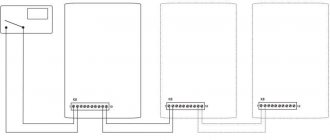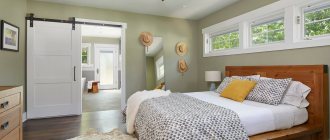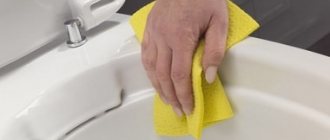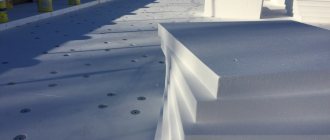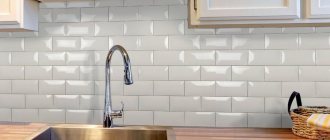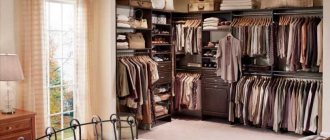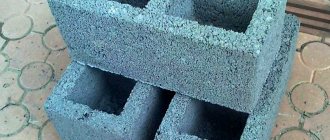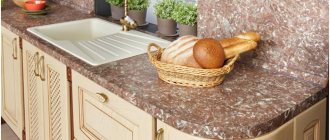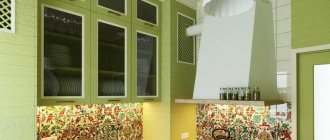Soft wall upholstery has a very long history - it is generally one of the oldest methods of interior decoration of “rich” rooms. And after a certain period of “oblivion”, such technology seems to be reborn. The fact is that soft wall panels have recently been actively used again for cladding individual areas or even the entire surface of walls.
Soft wall panels
They become especially relevant in multi-storey panel buildings, where there is “no” sound insulation, which very often interferes with the normal rest of the residents. Therefore, in some cases, such products are mounted not only on the walls, but also on the ceiling of rooms - they even dampen impact noise quite well. In addition to the practical side of the issue, the panels also become an excellent decorative element of the interior, especially since their range is so diverse that there is a finish for every taste.
Advantages of wall panels for the bedroom
- Easy to install as they are sold in ready-made pieces.
- They do not require preliminary thorough and deep treatment of the walls.
- Can be mounted on uneven surfaces.
- Hides defects, electrical wires and other communications.
- They have good sound and heat insulation qualities.
- Durable.
- Pleasant to the touch.
Another important advantage is that panels are often sold as separate elements, rather than as a single monolithic surface. Using small fragments, like a construction set, you can assemble decor of any size and shape.
This is especially valuable in small, narrow or simply non-standard bedrooms. The possibility of variable assembly will also be appreciated by owners of massive furniture, which must be played with, taking into account its presence.
Flaws
- quite high price;
- even with minor damage, you will have to replace it entirely;
- Quite a lot of dust accumulates in uneven surfaces and requires frequent cleaning;
- soft decorative panels will certainly fit well into any interior; will create a special atmosphere and comfort in the room;
- the choice of such panels is extremely diverse;
- At the same time, they are very easy to attach to walls.
Some of the details that were presented in the article can be seen in more detail in the video.
Cons of wall panels
- Soft volumetric panels are more expensive than traditional wallpaper and wall paints.
- Not suitable for rooms with high humidity.
- Over time, dust and odors accumulate and require deep professional cleaning.
- It is impossible to hang something bulky (shelf, TV) on the wall if you do not first provide for fastenings, even before installing the panels.
Installation features
To fix the soft panel on the wall in the bedroom, any fastening bolts or screws can be used, depending on the type of base material. If this is brickwork, then holes are first made into which spacer pads are driven; they will securely hold the dowel inside the cavity.
Fastening to a wooden base is much simpler; there is no need to install a spacer, but simply screw a sheet of plywood with panels right through to the wall. Places for screw heads should be chosen in invisible places, for example, in the corners of the part, slightly tilting the fabric upholstery.
Also, some experts suggest gluing these elements to the base using PVA. This method is rarely used, since it requires a flat wall surface and additional processing.
Thus, regardless of the complexity of the bedroom design project, soft wall panels are excellent for decoration, will decorate any interior and will give unusualness and individuality to the entire room.
What are soft wall panels made of?
The basic composition of any wall panels is a solid base, soft filler and upholstery material.
Plywood, chipboard or fiberboard sheets, and PVC are used as the base.
The softness and plumpness of the panels is given by polyurethane foam (better known as foam rubber) or padding polyester. With foam rubber they will be more voluminous and thicker, but over time the filler may fall down a little under its own weight. Sintepon makes the panels lighter; it is preferable in models with a screed.
Upholstery material is the most variable component. There are three principle groups:
- Genuine Leather;
- Leatherettes;
- Textile.
Reviews
“We attached soft panels to the surface of the old bar counter. Thanks to this, the interior of the restaurant has changed significantly. It’s now comfortable to sit next to such a counter and its surface is easy to clean.” Alexander, Volgograd
“In the interior of the restaurant in a classic style, wall panels with a carriage frame made of light beige leather were installed. They look great and blend in with the furniture.” Olga, Samara
“We secured the panels to a plasterboard partition. This partition is very convenient to move and can be used to cover unsightly areas with plumbing and wires. No one will notice anything behind the panels.” Pavel, Moscow
“We finished all the walls with soft wall panels. We have a karaoke bar and need effective soundproofing. It turned out very well and the neighbors are not complaining.” Dmitry, Sochi
“Our restaurant is located in a very old building. The walls crumble badly and cannot be covered with decorative materials.”
“The problem was solved by decorative soft panels on a frame made of aluminum profiles. Moreover, they installed all the walls in a room of 300 square meters. m in four days." Vladimir, Ekaterinburg
Finish options
Obviously, genuine leather (and suede) trim is the most expensive option. By its very presence it adds luxury to any room, but it also requires an appropriate setting. Furniture made of natural wood, plain or multi-colored embossed wallpaper will harmoniously combine with leather panels.
Faux leather is a more budget option for a respectable bedroom. Modern artificial materials are in no way inferior to their natural ancestor. They look decent, do not accumulate dust, and can even be wet cleaned.
Fabric upholstery is the most common. In addition to a wide variety of colors and patterns, textiles allow the use of various tie techniques. The most popular of them - carriage - resembles plump diamonds with decorative buttons or studs in the corners.
It is fabric panels that are considered the most comfortable and suitable for the atmosphere of the bedroom. The effect is enhanced by materials that are pleasant to the touch and look, such as:
- Velours;
- Velvet;
- Atlas;
- Silk;
- Tapestry.
Ensembles where the upholstery of panels, bed frames, blankets, decorative pillows or other elements are made of the same fabric look great.
Glass
In the manufacture of this type, tempered glass is used, which is durable and wear-resistant. The glass version of the panels is varied. Their surface can be either matte or smooth glossy. 3D panels in the bedroom are considered new.
Modern versions of glass coatings can imitate various natural materials, such as stone, brick, wood, etc. They can be equipped with lighting, which will advantageously emphasize the uniqueness of the room and make the room more spacious.
The only negative that may be present during operation is the formation of stains, smudges or fingerprints on the glass. To avoid them, you will have to carefully care for the material.
How panels are attached to walls
Several mounting options are used, but in any case, the work begins with careful measurements and markings of the wall.
Fundamentally different ways:
- Glue;
- Frame;
- Fastening elements.
The first group combines PVA glue, modern “liquid nails,” and double-sided tape. Panels with a self-adhesive back side are available for sale. PVA is applied to the entire surface of the panel, and construction acrylic adhesive is enough to be applied dotted or in zigzags.
- The frame method is essentially assembling a soft panel directly on the wall. To begin with, a frame is assembled from wooden slats over the entire surface.
- The slats are fixed with dowels. Then soft filler is glued between the slats.
- The final stage is covering with fabric. The fabric is fixed on the longitudinal and transverse slats with decorative nails.
- You can use a simple furniture stapler with staples, and then seal them with a beautiful braid that matches the fabric.
Solid large panels are difficult to glue, so they are hung by drilling holes in the base. Screws are firmly fixed to the wall and a soft panel is hung on them.
Recently, a magnetic fastening method has also appeared. If the manufacturer has equipped the panels with a sufficient number of magnets, then you can attach a metal plate to the wall and the base of the panel will “stick” to it perfectly.
Advantages
- The dirt and moisture-repellent surface of the soft panels has a service life of about 25 years;
- the internal composition helps reduce the noise level in the room and retains heat;
- the products do not emit harmful substances and are fireproof;
- the panels are easily attached to the wall, masking its defects and irregularities;
- it is possible to reuse soft panels after dismantling.
DIY wall panels in the bedroom (step by step instructions)
It will not be difficult for a craftsman who is familiar with the main types of furniture work and tools to make soft panels on his own. All materials are available both at specialized wholesale stores and in retail sales.
The general sequence of actions is as follows.
- Develop a sketch of products. Calculate their size, shape, quantity.
- According to the calculated values, cut a sheet of chipboard (or other material) and cut the seal into the same pieces (without indents or allowances).
- The fabric is cut taking into account the thickness of the panel and the fold on the reverse side. It is fixed first on two opposite sides, then on the rest with a furniture stapler. Be sure to pull the fabric tightly and evenly. The process is similar to upholstering the seat of a stool or chair.
Advice! If you plan to stitch the panels, then the holes for the threads that secure the buttons must be drilled in the base in advance.
The buttons are secured with strong acrylic thread and secured at the back with the same furniture stapler. It is better to place several staples in different directions. It is also important to maintain good tension.
The undeniable advantages of making soft panels yourself:
- At any time, you can change the design idea for the bedroom, add or reduce the number of elements, take a different fabric;
- Non-standard elements (usually narrow pieces or halves in the corners of the room) are made just as quickly as standard ones; no need to specially order them and wait;
- Independent selection of materials gives confidence in their quality and environmental safety;
- Having leftover plywood or fiberboard, padding polyester from other works, you can save a lot;
- There is no chance of paying and receiving a product of the wrong quality or configuration due to a manager’s mistake.
One should not remain silent about the fact that repairs made by oneself always bring more satisfaction than those ordered and paid for by craftsmen.
Materials used
A bedroom with soft wall panels looks unusual and modern; these details create an individual interior and also perform many functions, such as soundproofing the room and providing additional heat retention. Soft wall panels for the bedroom can be made from various materials, including:
- Soft leather panels for walls; in this case, genuine leather is used, which is used to cover the textured base. The use of such material adds luxury to the interiors and creates massiveness of the entire structure, giving the bedroom an exclusive appearance. But genuine leather is very expensive, so not many can afford the installation of soft panels made from such material. Despite this factor, leather soft wall panels are often used as a headboard for a bed or as an extension of this element;
- Wall panels made of artificial leather. A high-quality material that is suitable for those who want to save money, since its cost is slightly lower than a natural element, and its appearance is practically no different from the natural one. In addition, such a surface is much easier to clean and does not require special operating conditions;
- Textile upholstery of panels on the bedroom wall is the most common finishing option; the cost of the fabric is much lower than leatherette, but thanks to the many variations of texture and color, its use makes it possible to create any form of design, as well as give a luxurious look to the room for relatively little money.
The listed upholstery options for a soft panel are the main elements; in addition to them, there are other materials, for example, satin fabric, synthetics or plastic polymer films. These materials are rarely used for decoration, since they are not natural and are not suitable for finishing residential premises.
In addition to the upholstery fabrics mentioned above, the soft wall panels used to decorate a bedroom in an apartment will need several more elements, including:
- The base, which can be any flat platform, is most often used thick-walled plywood or chipboard. Such materials are quite hard and strong, and are also able to support the weight of the entire structure. In addition, if wood parts are used, this makes it easier to install the panel on the wall, since there is no need to drill additional holes for mounting screws;
- A soft layer between plywood and finishing fabric. This material can be used as medium-thick foam rubber or synthetic padding mats. Each of the fillers has its own pros and cons: for example, when using foam rubber, the surface will be more textured, thicker and softer, but making such a panel is much more difficult than with padding polyester. The latter is more suitable for beginners in this business, since there is less chance of making design errors.
Also, for the production of soft panels intended for wall decoration, you will need tie strips of fabric or wide buttons, which, when fixed to the base through the covering material, form a pattern and relief, depending on the requirements of the design project. It is these details that play the role of barriers and give the necessary texture.
Photo of soft wall panels for the bedroom
Soft walls in the interior: positive and negative aspects
The advantages of soft upholstery in the bedroom include:
- unique home design. The emergence of a new branch in bedroom interior design;
- a wide range of textures, color palettes, sizes and patterns;
- implementation of any style solutions;
- the effectiveness of additional sound and thermal insulation of the room. The soft panel is popular for children's rooms and bedrooms;
- environmental safety of the materials used;
- a wide range of options for changing the decor and design of the wall surface, implementing original combinations;
- the possibility of using new facing materials not only on a wide scale of the wall, but also in a separate zone;
- the possibility of zoning the interior space of a room into separate zones;
- good adhesion to any type of wall surface;
- a soft wall effectively masks the old base of the bedroom;
- ease and simplicity of installation work;
- possibility of making soft panels in one person;
- ease and simplicity of care of the coating;
- Some options, for example, leather covering, are characterized by a high degree of wear resistance and practicality;
- good resistance to mechanical stress;
- tendency to absorb noise in the bedroom.
The negative aspects include:
- high pricing policy for materials and remuneration of specialists;
- the soft fabric covering is not durable;
- creating exclusive decor to order will be very expensive;
- Fabric and leather panels require regular maintenance. If this is not done, the aesthetics of the appearance of the wall will be lost.

